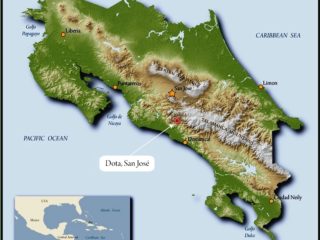Costa Rica
Costa Rica’s innovative coffee producers create a rich variety of flavor profiles, ranging from squeaky clean and citrusy fully washed coffees, syrupy sweet honey processed coffees, to richly perfumed natural coffees.

Showing all 36 results
-

Costa Rica Black Honey
33484 – GrainPro Bags – April 2024 Shipment – SHANGHAI
Future Shipment3033484 – GrainPro Bags – April 2024 Shipment – SHANGHAI
-

Costa Rica Don Claudio Natural Caturra Catuai SHB EP
32086 – Ecotact Bags – SPOT SHANGHAI
Spot132086 – Ecotact Bags – SPOT SHANGHAI
-

Costa Rica El Poeta SHB EP
28911-3 – SPOT COSEATAC
Lemon, hibiscus, pineapple, brown sugar, clean, balancedSpot1528911-3 – SPOT COSEATAC
$4.21 /lb -

Costa Rica El Poeta SHB EP
28911-4 – SPOT RCWHSE
Lemon, hibiscus, pineapple, brown sugar, clean, balancedSpot2428911-4 – SPOT RCWHSE
$3.56 /lb -

Costa Rica Mariposa Finca Rosa Linda SHB EP
28912-3 – GrainPro Bags – SPOT RCWHSE
Peach, salted caramel, baking spice, sweetSpot7928912-3 – GrainPro Bags – SPOT RCWHSE
$3.56 /lb -

COSTA RICA ORGANIC FINCA AMISTAD SHB EP
32202 – GrainPro Bags – SPOT RCWHSE
 Lemon, orange, hibiscus, brown sugar, milk chocolateSpot41
Lemon, orange, hibiscus, brown sugar, milk chocolateSpot4132202 – GrainPro Bags – SPOT RCWHSE
$4.70 /lb -

COSTA RICA ORGANIC FINCA AMISTAD SHB EP
32202-2 – GrainPro Bags – SPOT CCARGO
Lemon, orange, hibiscus, brown sugar, milk chocolateSpot532202-2 – GrainPro Bags – SPOT CCARGO
$4.87 /lb -

COSTA RICA ORGANIC FINCA AMISTAD SHB EP
32202-3 – GrainPro Bags – SPOT COSEATAC
Lemon, orange, hibiscus, brown sugar, milk chocolateSpot732202-3 – GrainPro Bags – SPOT COSEATAC
$4.81 /lb -

COSTA RICA ORGANIC FINCA AMISTAD SHB EP
32202-4 – GrainPro Bags – SPOT DUPUYHOU
Lemon, orange, hibiscus, brown sugar, milk chocolateSpot1232202-4 – GrainPro Bags – SPOT DUPUYHOU
$4.85 /lb -

COSTA RICA ORGANIC FINCA AMISTAD SHB EP
32205 – GrainPro Bags – SPOT RCWHSE
Lime, apricot, peanut butter, sweetSpot17532205 – GrainPro Bags – SPOT RCWHSE
$4.70 /lb -

Costa Rica Perla Negra Natural
33483 – GrainPro Bags – April 2024 Shipment – SHANGHAI
Future Shipment6033483 – GrainPro Bags – April 2024 Shipment – SHANGHAI
-

Costa Rica RFA West Valley La Candelaria Estate
29079-2 – SPOT RCWHSE
Cinnamon, pecan, floral, buttercream icing, dark chocolateSpot27529079-2 – SPOT RCWHSE
$3.41 /lb -

Costa Rica RFA West Valley La Candelaria Estate
29257-5 – SPOT RCWHSE
Lemon, pineapple, passionfruit, chocolate, candy-sweetSpot12129257-5 – SPOT RCWHSE
$3.56 /lb -

Costa Rica Santa Maria De Dota AA EP
28679-2 – GrainPro Bags – SPOT SEAFORTH
Raspberry, pear, orange blossom, dark chocolate, juicySpot428679-2 – GrainPro Bags – SPOT SEAFORTH
$3.56 /lb -

Costa Rica Santa Maria De Dota AA EP
32902 – GrainPro Bags – Intend Ship: May 04, 2024 – CCARGO
Future Shipment25432902 – GrainPro Bags – Intend Ship: May 04, 2024 – CCARGO
-

Costa Rica Santa Maria De Dota AA EP
33056 – GrainPro Bags – July 2024 Shipment – RCWHSE
Future Shipment21033056 – GrainPro Bags – July 2024 Shipment – RCWHSE
-

Costa Rica Tarrazu La Esperanza Estate Familia Monge Natural
33034 – GrainPro Bags – April 2024 Shipment – RCWHSE
Future Shipment6933034 – GrainPro Bags – April 2024 Shipment – RCWHSE
-

Costa Rica Tarrazu La Pastora SHB EP
28787-4 – Ecotact Bags – SPOT RCWHSE
Cranberry, lemon/lime, cocoa powder, juicySpot6528787-4 – Ecotact Bags – SPOT RCWHSE
$3.41 /lb -

Costa Rica Tarrazu La Pastora SHB EP
28791-1 – Ecotact Bags – SPOT RCWHSE
Lemon/lime, cherry cola, vanilla, milk chocolateSpot21928791-1 – Ecotact Bags – SPOT RCWHSE
$3.56 /lb -

Costa Rica Tarrazu La Pastora SHB EP
28792-1 – Ecotact Bags – SPOT COSEATAC
Stone fruit, milk chocolate, syrupy, sweetSpot2028792-1 – Ecotact Bags – SPOT COSEATAC
$4.34 /lb -

Costa Rica Tarrazu La Pastora SHB EP
28792-2 – Ecotact Bags – SPOT RCWHSE
Stone fruit, milk chocolate, syrupy, sweetSpot6828792-2 – Ecotact Bags – SPOT RCWHSE
$3.56 /lb -

Costa Rica Tarrazu La Pastora SHB EP
28797-1 – Ecotact Bags – SPOT RCWHSE
Orange, lemon, caramel, sweetSpot23428797-1 – Ecotact Bags – SPOT RCWHSE
$3.56 /lb -

Costa Rica Tributos Del Ota Cerro Nuboso Honey Fermentation
*50805C* – 26212 – 30.0 kg Box/Vacuum Pack – SPOT SHANGHAI
Dried Apple, Caramel, cocoaSpot7*50805C* – 26212 – 30.0 kg Box/Vacuum Pack – SPOT SHANGHAI
-

Costa Rica West Valley Finca Cecilia Honorio Jimenez Natural
30593 – GrainPro Bags – SPOT RCWHSE
Dried cherry, black currant, concord grape, tangy citrus, chocolate fudgeSpot830593 – GrainPro Bags – SPOT RCWHSE
$5.50 /lb -

Costa Rica West Valley Monte Crisol SHB EP
28861-4 – SPOT RCWHSE
Butterscotch, malt, toasted marshmallow, cocoaSpot10428861-4 – SPOT RCWHSE
$3.41 /lb -

Costa Rica West Valley Monte Crisol SHB EP
32904 – GrainPro Bags – ETA: May 25, 2024 – RCWHSE
Afloat932904 – GrainPro Bags – ETA: May 25, 2024 – RCWHSE
-

Costa Rica West Valley Monte Crisol SHB EP
32905 – GrainPro Bags – July 2024 Shipment – RCWHSE
Future Shipment932905 – GrainPro Bags – July 2024 Shipment – RCWHSE
-

Costa Rica West Valley Monte Crisol SHB EP
32912 – SPOT RCWHSE
Limeade, fuji apple, cola, chocolateSpot1932912 – SPOT RCWHSE
$3.75 /lb -

Costa Rica West Valley Monte Crisol SHB EP
32913 – GrainPro Bags – ETA: May 25, 2024 – RCWHSE
Afloat532913 – GrainPro Bags – ETA: May 25, 2024 – RCWHSE
-

Costa Rica West Valley Monte Crisol SHB EP
33042 – ETA: May 18, 2024 – RCWHSE
Afloat8933042 – ETA: May 18, 2024 – RCWHSE
-

Costa Rica West Valley Monte Crisol SHB EP
33043 – ETA: May 25, 2024 – RCWHSE
Afloat24533043 – ETA: May 25, 2024 – RCWHSE
-

Costa Rica West Valley Monte Crisol SHB EP
33044 – GrainPro Bags – June 2024 Shipment – RCWHSE
Future Shipment24533044 – GrainPro Bags – June 2024 Shipment – RCWHSE
-

Costa Rica West Valley Monte Crisol SHB EP
33045 – GrainPro Bags – July 2024 Shipment – RCWHSE
Future Shipment18133045 – GrainPro Bags – July 2024 Shipment – RCWHSE
-

Costa Rica West Valley Monte Crisol SHB EP
33821 – GrainPro Bags – June 2024 Shipment – SHANGHAI
Future Shipment27533821 – GrainPro Bags – June 2024 Shipment – SHANGHAI
-

Costa Rica West Valley Monte Crisol SHB EP
33912 – GrainPro Bags – April 2024 Shipment – COSEATAC
Future Shipment27533912 – GrainPro Bags – April 2024 Shipment – COSEATAC
-

ROYAL GEM COSTA RICA ORGANIC FINCA AMISTAD SHB EP 50 LB
32202-5 – SPOT RCWHSE
Lemon, orange, hibiscus, brown sugar, milk chocolateSpot4532202-5 – SPOT RCWHSE
$300.89 /box







